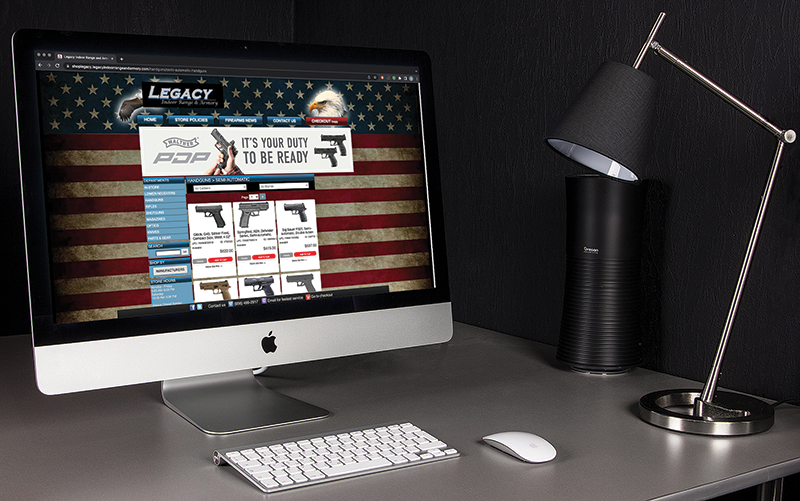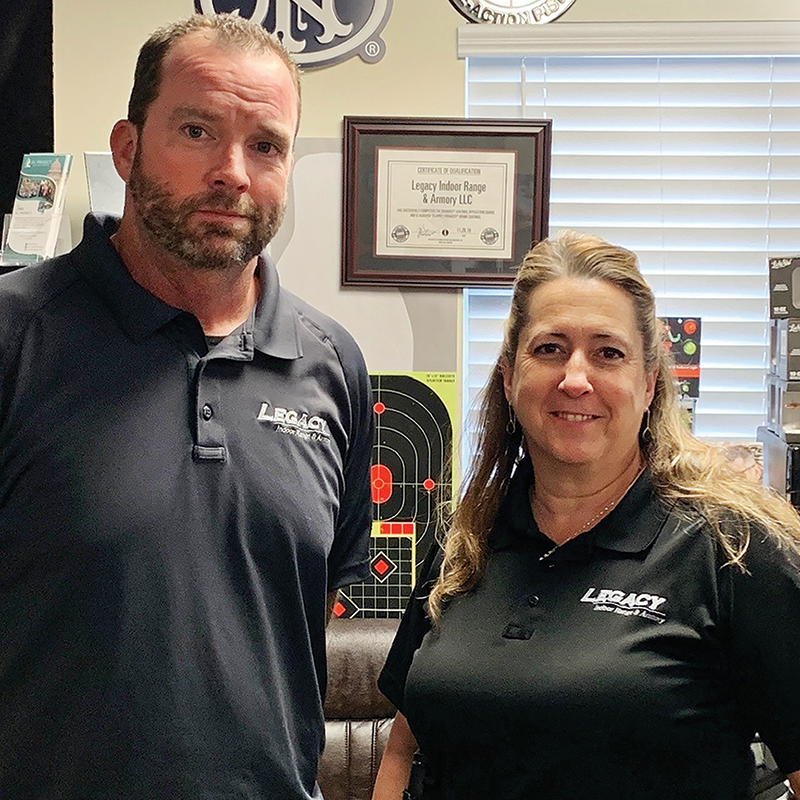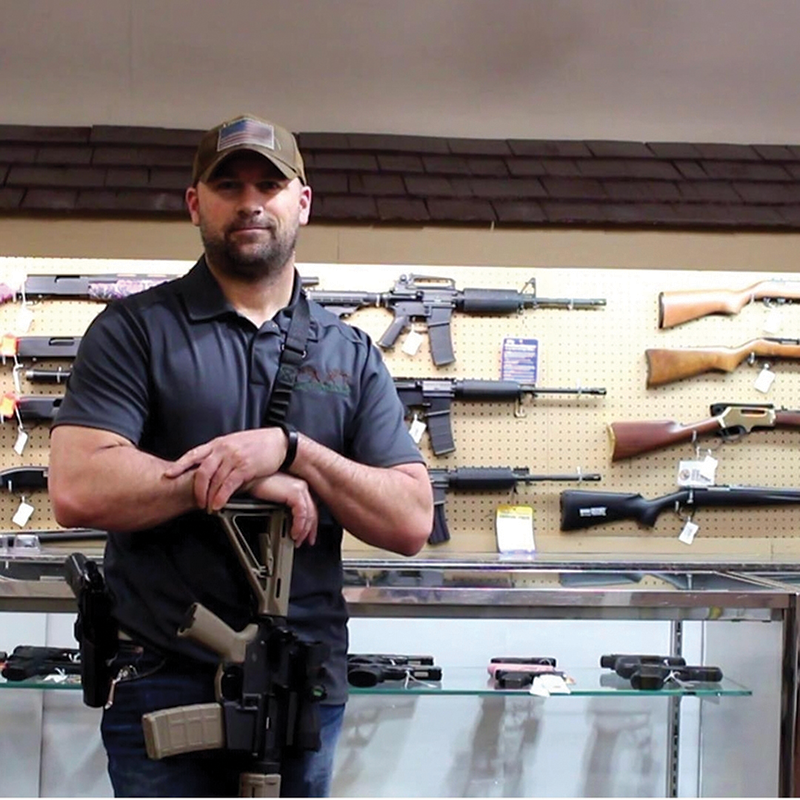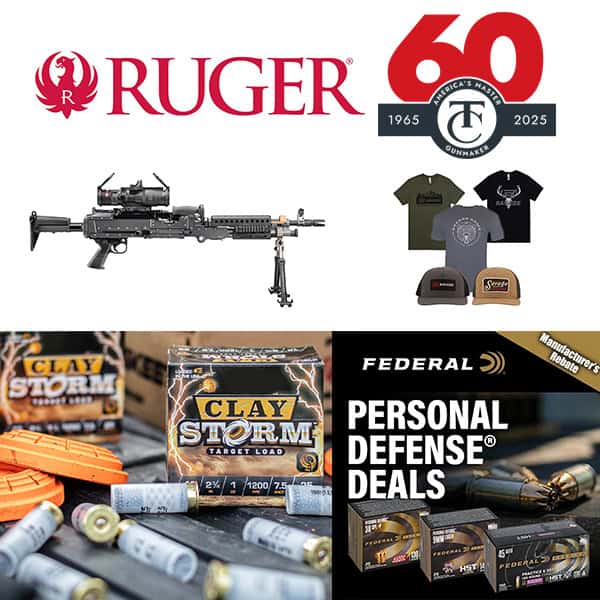At The Starting Line
Use E-Commerce To Drive More Sales
During their first five years in business, the owners of Legacy Indoor Range & Armory were happy with a homegrown website. For the most part, it did what it needed to do: It made sales here and there, and it gave the small shop in Cinnaminson, N.J., an online footprint.
Then came COVID and a chaotic mix of developments that turned the industry, along with the rest of the world, on its head. Swamped with orders, they made a difficult decision.
“The website was almost impossible to maintain with how fast inventory was changing,” said Melissa Deeney, Legacy co-owner. “We basically stopped all e-commerce. I mean everything, including the website and GunBroker.com. We just couldn’t keep up with it.”
Now with a bit of breathing room, the shop is venturing back into e-commerce, but with a different approach. They recently signed on with Gearfire, one of several firms with website services geared toward gun stores.
Legacy’s new online site provides a real-time look at the shop’s inventory, while also providing customers access to offerings from a dozen or so distributors.
The company’s journey offers a glimpse into an ongoing trend in an industry that’s been reluctant to wholly embrace e-commerce. Coming out of the COVID pandemic, more shops are turning a more serious eye toward online sales.
“If you want to stay in the business, you’re going to have to do e-commerce. And you have to efficiently ship stuff. People want it quick. Everybody expects every store to be like Amazon.”
Paul Toth, Owner TAAP Outdoors Wakeman, Ohio
The Pandemic & A New Generation’s Impact
Celerant Technology is another firm offering e-commerce services, as well as point-of-sale technology to the industry. In the days before the pandemic, about 60% of the company’s new dealer customers were interested in the e-commerce component. Today, this figure is 95% or more, according to Michele Salerno, Celerant director of marketing and assistant VP.
“I think even prior to COVID, the industry was evolving at a rapid pace whether the retailers liked it or not,” Salerno noted. “Going through two years of COVID craziness just escalated it.”
Also contributing to the trend is what might best be described as a changing of the guard in gun store ownership. Around the country, parents are turning stores over to their children who have a different take on the value of the internet as a sales tool, said Chad Seaverns, Gearfire’s chief operating officer.
“We’re seeing a lot of younger firearms dealers, either because of generations turning over or just younger people starting new businesses,” Seaverns said. “They know the importance of being online, whereas some of the boomer generation feel like they’ve done perfectly fine all these years without a website.”
Among this newer generation of owners is Paul Toth, who opened TAAP Outdoors in Wakeman, Ohio, after leaving law enforcement in 2016. He also tried his hand at developing his own e-commerce platform before becoming frustrated and turning to Celerant.
“If you want to stay in the business, you’re going to have to do e-commerce,” Toth argued. “And you have to efficiently ship stuff. People want it quick. Everybody expects every store to be like Amazon.”
Just Building It Doesn’t Mean They Will Come
Toth also quickly realized there’s a lot more to developing a successful e-commerce presence than simply signing up with companies like Celerant or Gearfire.
“It doesn’t work like that. You have to work on it,” Toth shared. “I sit here in the mornings and I click around the website to see if there are broken links or something that’s not jiving with what’s actually here.”
There also are things you can do with your site — particularly if you’re using a company that provides templates — to make it more valuable. Both Celerant and Gearfire offer the ability to do customization. Store-specific inventory can be added to allow shops with a particular niche to promote those products. Used guns can be listed. Photos can be uploaded. Descriptions can be edited.
“Do a lot of dealers actually go in and do it? No, because they don’t have time,” Salerno contended. “Do the more innovative dealers do it? Absolutely.”
There’s one very important reason to do as much customization as possible. It all comes down to search engine optimization (SEO). It’s what search engines like Google take into account when online users are browsing. Unique sites are more likely to be ranked higher in search results.
“When every single site looks exactly the same and has the same website copy, from an SEO perspective, you can’t get much worse than that,” Salerno said.
Even if you don’t have the time to churn out a unique website, there is still value in having an online presence, Seaverns argued.
If you go with an unmodified template, it will make some sales here and there. But more importantly, it secures your real estate in cyberspace. Without it, you risk losing out on potential customers.
“It’s no longer an option not to be online,” Seaverns asserted. “It’s how consumers start their shopping experience.”
Real-Time Updates
For both of these gun shops, plans to use homegrown sites were derailed, at least partially, by inventory issues — specifically, making sure online inventory matched what was actually in the store.
Without it, you may be refunding online sales that can’t be backed up with what is actually on the shelves. Or customers will be driving to your store to buy something you don’t have.
“If it’s not here when they get here, it leaves a bad taste in anybody’s mouth,” Toth remarked.
To avoid this, you’ll need a feature showing customers what’s physically in the shop, as opposed to what’s available through your distributor networks — the so-called “endless aisle” of products you would never have enough room to stock.
Both Celerant and Gearfire, for example, allow shoppers to filter search results to show what’s in the store — or a specific store if the business has multiple locations.
Even with these protective features, Deeney said they still urge customers (through a website message) to call to verify availability. They also suggest buying the item from the website before heading to the store to pick it up. It functions like a reservation.
“This gives us the opportunity to secure the item,” she shared. “If for some reason the website is wrong, and we don’t actually have it, we can notify them before they make the drive.”
Someone To Own It
Another key to success is making sure one employee, rather than everyone, is responsible for your e-commerce operation.
“We see more success with retailers who have someone dedicated to the site, or having someone basically ‘own’ the channel,” said Seaverns with Gearfire.
Toth is planning for this down the line as business grows. He envisions having someone spend somewhere around 60% of their time on e-commerce and the other 40% on general store inventory. This person would be responsible for shipments, pulling orders, securing FFLs for gun shipments, handling site updates and posting unique items.
“When you’re out doing the registers, you can’t keep up with everything,” Toth noted. “I wouldn’t want someone trying to handle orders in-between customers.”
“The most important thing to always keep in mind is your provider supports the firearms industry now and will continue to do so for the long haul.”
Michele Salerno, Director of Marketing & Asst. VP Celerant Technology
Picking A Reliable Provider
For any gun shop considering its e-commerce future, one of the most important factors is the commitment of your chosen provider, particularly in an era when corporations aren’t shy about distancing themselves from guns at a moment’s notice.
Consider what happened after 2018’s decision by Shopify to sever ties with customers selling semi-automatic firearms. And in 2019, business software firm Salesforce announced it would no longer allow its products to be used for selling semi-automatic guns and various accessories.
“The most important thing to always keep in mind is your provider supports the firearms industry now and will continue to do so for the long haul,” advised Salerno, with Celerant.
It was something both Deeney and Toth took into account when choosing their respective e-commerce partners. Toth talked about the year’s worth of time he invested in choosing and preparing for his new e-commerce site.
“You can’t just change these on a whim,” Toth concluded. “It’s not a simple thing. It’s not just flipping a switch.”










